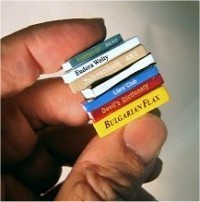E-Singles: Nothing New To Indie Authors
 I just read a piece over at Techdirt on the so-called “rise of e-singles.” Timothy Geigner describes these as “works of complete literature in the neighborhood of 8k-10k words,” and quotes Laura Hazard Owen at Paid Content as saying Amazon’s Kindle Singles store has “283 singles.”
I just read a piece over at Techdirt on the so-called “rise of e-singles.” Timothy Geigner describes these as “works of complete literature in the neighborhood of 8k-10k words,” and quotes Laura Hazard Owen at Paid Content as saying Amazon’s Kindle Singles store has “283 singles.”
Owen writes that 2012 was the “year of the e-single.” Geigner uses one of the more carefully qualified examples of journalism-speak I’ve seen in quite some time and hedges his bets with the claim that “one of the buzzwords in the publishing industry is quickly becoming e-singles.”
For all we know, signs also point to one of the other buzzwords in the publishing industry quickly becoming “branding by opportunity,” since that’s all e-singles really are.
E-singles are nothing new to the indie publisher or indie author. We’ve been publishing short stories, essays, and short-form non-fiction and instructional content and happily earning our 35% to 70% for years now. All that’s “new” is that Amazon.com created a category in their store and set themselves up as a gatekeeper if you want your short-form e-book to be called a “single.”
What Are Amazon E-Singles, and Why Are Even A Thing At All?
Amazon.com describes e-singles as “compelling ideas expressed at their natural length.” That’s amusing and something of a head-shaker to me for a few reasons:
Compelling Ideas Whatnow?
In “compelling ideas,” Amazon apparently includes fiction, journalism, memoirs, essays, and something called “page-turning narratives.” It’s what the rest of us call, you know, most of the things authors write and readers read.
And seriously, do all the narratives that don’t inspire you to turn (flick) the page get relegated to some other part of the Kindle store?
No. They get relegated to the bottom of the sales rankings by the same rules of natural selection as everything else.
“Natural Length” Is The New “Gluten Free”
The phrase “expressed at their natural length” reflects one of the biggest problems with so-called “traditional” publishing: that books and magazine articles couldn’t be too long or too short, because printed, tangible content is ultimately at the mercy of resource allocation, shipping costs, shelf space (okay, that’s part of resource allocation) and even payroll.
The economics of brick-and-mortar retail practically created modern word count constraints as sure as it created arbitrary categorization by genre.
Thing is, e-books erased both of those constraints a decade ago. Calling shorter works “e-singles” doesn’t make them special or new. Amazon isn’t innovating. They’re labeling.
Will You Hold That Gate Open For Me?
The “invention” of e-singles represents another move by Amazon to assume the role of gatekeeper.
Now, don’t get me wrong: I’m not one of those indie author conspiracy theorists interpreting every press release, technical glitch and policy change as the oppressive thumb of Zon pressing down on the back of my neck. So long as Amazon lets authors publish original material any way they want, and so long as Amazon continues to personally provide me with 70% to 80% of my sales every month, hey, let them invent their little niches and imprints.
However: readers, authors and tech / publishing bloggers should not be fooled into thinking e-singles are anything special, different, new or revolutionary.
What’s The Big Deal?
Here’s why I think it’s important that we recognize e-singles as an arbitrary category, a marketing initiative and nothing more, and why it’s kind of silly to be hyping short e-books as some new thing:
There’s a risk that aspiring indie authors will visit Amazon, notice the Kindle Singles department, and see that one has to submit their works to Amazon in order to be considered worthy of the Kindle Singles e-single branding. That might make some new authors think they can’t simply upload their short story, essay, memoir, how to, or novella via the Kindle Direct Publishing program — that they have to go through gatekeepers just as if the author was trying to break into the traditional publishing market.
It’s important that new indie authors understand they can put their own compelling ideas up for sale in the Kindle Store no matter what the length of the work is, natural or otherwise.
Indie Authors Aren’t Stupid
Of course, indie authors aren’t stupid, by and large. They should be able to figure this out for themselves. Even so, I interact with a lot of new and aspiring, and I know it’s easy to be overwhelmed by the process of indie publishing. I don’t want anything to add to the confusion.
Word Count Doesn’t Matter Any More
As I mentioned, word count isn’t something authors (or electronic publishers, or e-book retailers) should be concerned about any more. All works should be their “natural length.” Tell the story, communicate the message, provide the instruction… and take as many words as you need. No more, no less.
There is one area where you should be cognizant of the length of a piece, and that’s pricing. Authors, please take care to price your work at a rate that’s comparable to other, similar works of similar length. No one wants to pay $0.99 for one short story and $3.99 for another. Have it make sense for the market.
But don’t worry about what the market might call it. E-single, short, or whatever label the marketing mavens come up with next week… it doesn’t matter.
Your Thoughts
I’m betting some readers will have an opinion on the subject of e-singles, e-book marketing, arbitrary category and genre classification, and related subjects. I’d love you to share your views and talk about it in the comments!
This is a post from Matthew Wayne Selznick. Thanks for reading E-Singles: Nothing New To Indie Authors -- please click through and comment, and share with everyone you know!









